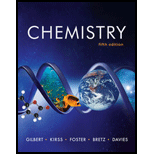
Concept explainers
Interpretation: The percent decrease in pressure of a sealed reaction vessel during the reaction between
Concept introduction: The reaction between nitrogen and hydrogen involves the formation of ammonia. When one mole of nitrogen reacts with three moles of hydrogen then it produces 2 moles of ammonia. The balanced equation is given below,
From the ideal gas equation, at constant temperature and volume, Pressure is directly proportional to the number of moles,
To determine: The percent decrease in pressure of a sealed reaction vessel during the reaction between
Answer to Problem 6.115QP
Solution
The percent decrease in pressure of a sealed reaction vessel during the reaction between
Explanation of Solution
Explanation
Given
The number of moles of
The number of moles of
So, the total number of moles that are present initially is,
The balanced chemical equation between
According to this equation,
During the reaction, half of the moles of
Therefore, the final number of moles
Since, half of the
Since,
The percentage decrease in pressure is calculated by the formula,
% decrease in pressure
Substitute the values of
Conclusion
The percent decrease in pressure of a sealed reaction vessel during the reaction between
Want to see more full solutions like this?
Chapter 6 Solutions
Smartwork5 Printed Access Card for Use with Chemistry: The Science in Context 5th Edition (SmartWork Access Printed Access Card)
 ChemistryChemistryISBN:9781305957404Author:Steven S. Zumdahl, Susan A. Zumdahl, Donald J. DeCostePublisher:Cengage Learning
ChemistryChemistryISBN:9781305957404Author:Steven S. Zumdahl, Susan A. Zumdahl, Donald J. DeCostePublisher:Cengage Learning ChemistryChemistryISBN:9781259911156Author:Raymond Chang Dr., Jason Overby ProfessorPublisher:McGraw-Hill Education
ChemistryChemistryISBN:9781259911156Author:Raymond Chang Dr., Jason Overby ProfessorPublisher:McGraw-Hill Education Principles of Instrumental AnalysisChemistryISBN:9781305577213Author:Douglas A. Skoog, F. James Holler, Stanley R. CrouchPublisher:Cengage Learning
Principles of Instrumental AnalysisChemistryISBN:9781305577213Author:Douglas A. Skoog, F. James Holler, Stanley R. CrouchPublisher:Cengage Learning Organic ChemistryChemistryISBN:9780078021558Author:Janice Gorzynski Smith Dr.Publisher:McGraw-Hill Education
Organic ChemistryChemistryISBN:9780078021558Author:Janice Gorzynski Smith Dr.Publisher:McGraw-Hill Education Chemistry: Principles and ReactionsChemistryISBN:9781305079373Author:William L. Masterton, Cecile N. HurleyPublisher:Cengage Learning
Chemistry: Principles and ReactionsChemistryISBN:9781305079373Author:William L. Masterton, Cecile N. HurleyPublisher:Cengage Learning Elementary Principles of Chemical Processes, Bind...ChemistryISBN:9781118431221Author:Richard M. Felder, Ronald W. Rousseau, Lisa G. BullardPublisher:WILEY
Elementary Principles of Chemical Processes, Bind...ChemistryISBN:9781118431221Author:Richard M. Felder, Ronald W. Rousseau, Lisa G. BullardPublisher:WILEY





